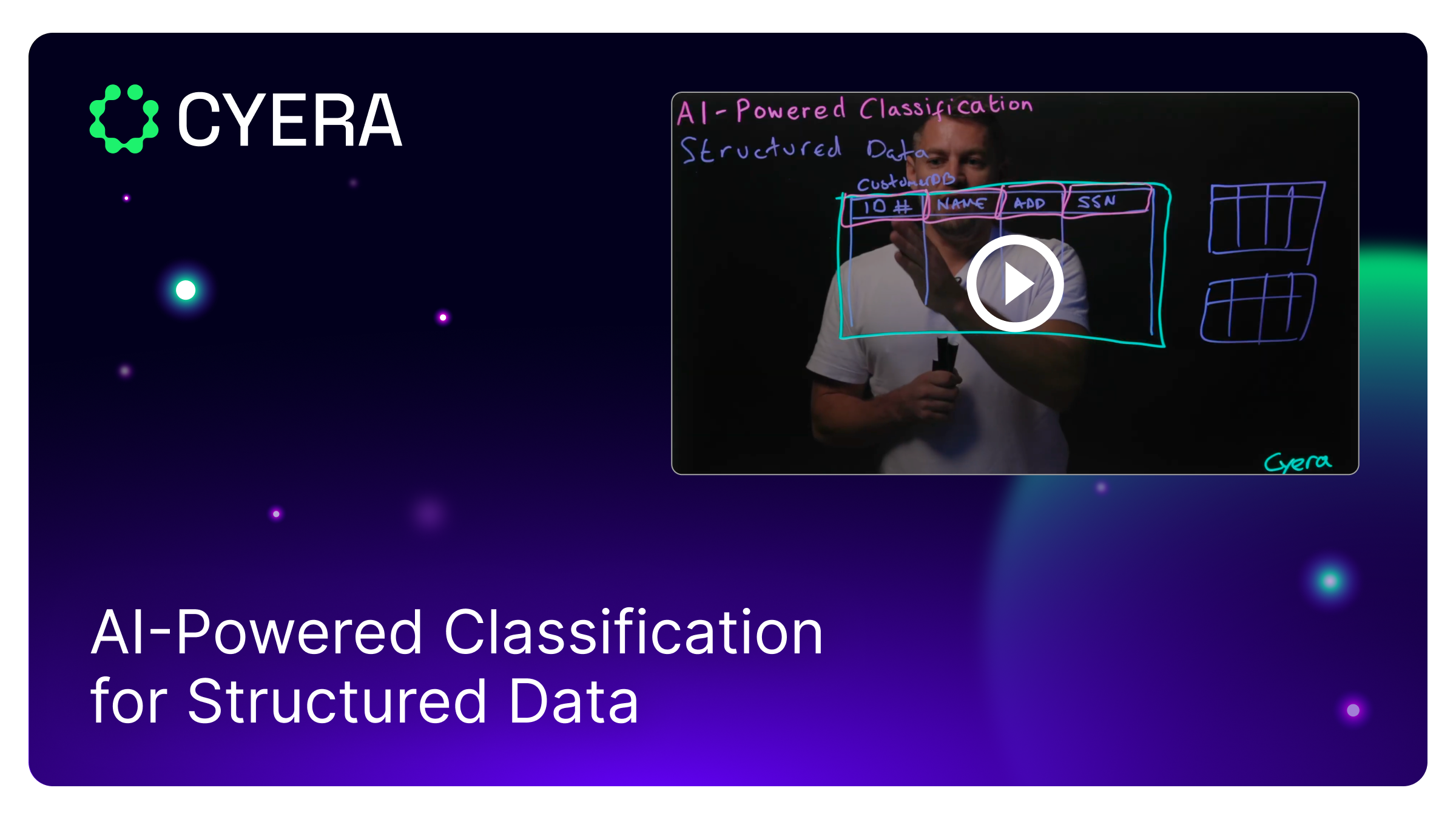Version V30 de Cyera et dernières innovations : sécurité, remédiation, classification et contrôle de l'IA
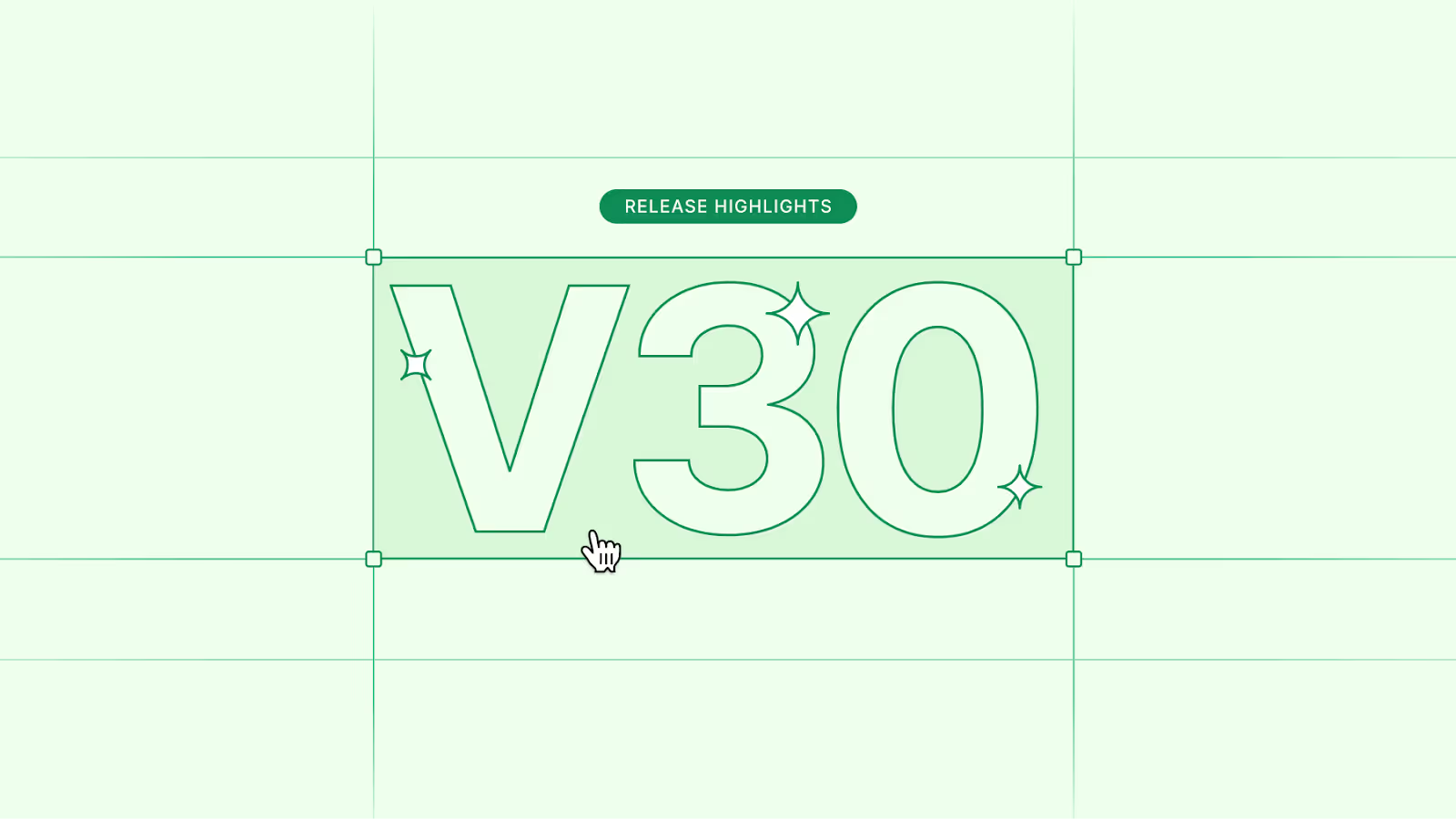
L'IA redéfinit notre façon de travailler et de sécuriser les données. Les données sensibles circulent désormais plus rapidement, via un plus grand nombre de systèmes, avec moins de supervision. Les équipes de sécurité sont censées suivre le rythme sans ralentir l'activité.
La dernière version de Cyera aborde ce moment de front. Il renforce la capacité de la plateforme à protéger les données dans les environnements cloud et sur site et apporte un contrôle intelligent aux outils d'IA qui y accèdent.
Ces innovations introduisent une protection en temps réel, un contexte de données plus approfondi et une automatisation intégrée. Qu'il s'agisse de gérer l'IA ou de remédier aux risques liés à Microsoft 365, ces mises à jour offrent aux équipes la clarté et le contrôle dont elles ont besoin pour agir rapidement et rester en sécurité.
Gardien de l'IA
Présentation d'AI Guardian
Bénéficiez d'une visibilité et d'un contrôle instantanés sur l'utilisation de l'IA
L'adoption de l'IA est en plein essor, mais la gouvernance des données et de l'IA n'a pas suivi le rythme. La plupart des équipes ne savent pas quels outils d'IA sont utilisés, à quelles données elles peuvent accéder ou comment elles sont protégées. Cyera change cela avec Gardien de l'IA. La première solution de bout en bout pour sécuriser l'IA avec une visibilité complète des données. Il protège tous les systèmes d'IA, des outils publics aux modèles internes, en passant par les données au repos et en mouvement.
AI Guardian intègre deux nouvelles solutions à la plateforme Cyera : AI-SPM et AI Runtime Protection.
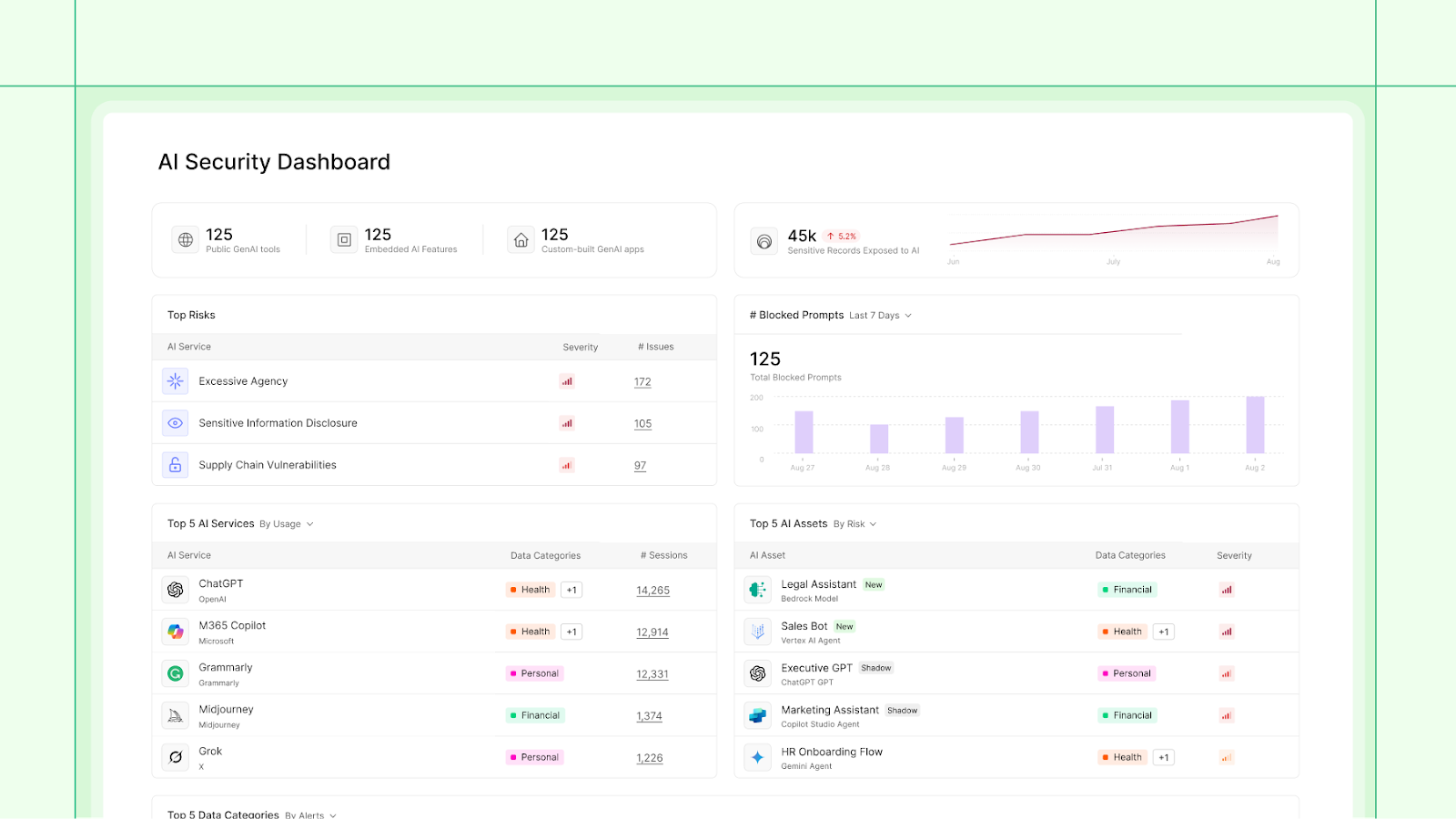
Gestion de la posture de sécurité de l'IA (AI-SPM)
Avec AI-SPM, vous pouvez inventorier tous les systèmes d'IA (par exemple, les copilotes, les modèles publics, les outils internes) et voir quelles données ils concernent. Cyera cartographie l'accès, signale la sensibilité, retrace la lignée et révèle les risques réglementaires.
Par exemple, lorsqu'une équipe marketing associe un chatbot à des données clients contenant des informations financières sensibles, Cyera identifie ce risque et peut prendre des mesures coercitives, telles que le masquage ou la révocation de l'accès pour réduire les risques.
Protection de l'exécution de l'IA
AI Runtime Protection empêche les données sensibles d'atteindre des modèles d'IA non gérés en temps réel ou l'accès non autorisé à des données sensibles via des outils d'IA internes au sein de l'organisation. Cyera surveille l'utilisation de l'IA au fur et à mesure et applique les politiques automatiquement.
Par exemple, si un représentant commercial colle des journaux de discussion sensibles dans un assistant IA, Cyera intercepte le contenu, bloque le transfert, alerte le propriétaire et suggère une rédaction, le tout avant que l'exposition ne se produise.
La protection AI Runtime de Cyera peut même intervenir lorsqu'un utilisateur tente de tromper un assistant IA pour qu'il révèle ses instructions cachées, ce que l'on appelle une injection rapide. Cyera détecte la tentative en temps réel, signale le comportement, reconnaît les données personnelles sensibles impliquées et transmet automatiquement l'incident pour enquête, empêchant ainsi toute utilisation abusive avant qu'un dommage ne soit causé.

Ensemble, AI Guardian comble la faille de sécurité des données d'IA en régissant l'accès et l'inférence dans un seul flux.
AI-SPM est en version bêta privée et AI Runtime Protection est disponible en accès anticipé. Contactez votre représentant Cyera dès aujourd'hui pour en savoir plus !
Assistant Omni AI
Rencontrez votre assistant Omni AI
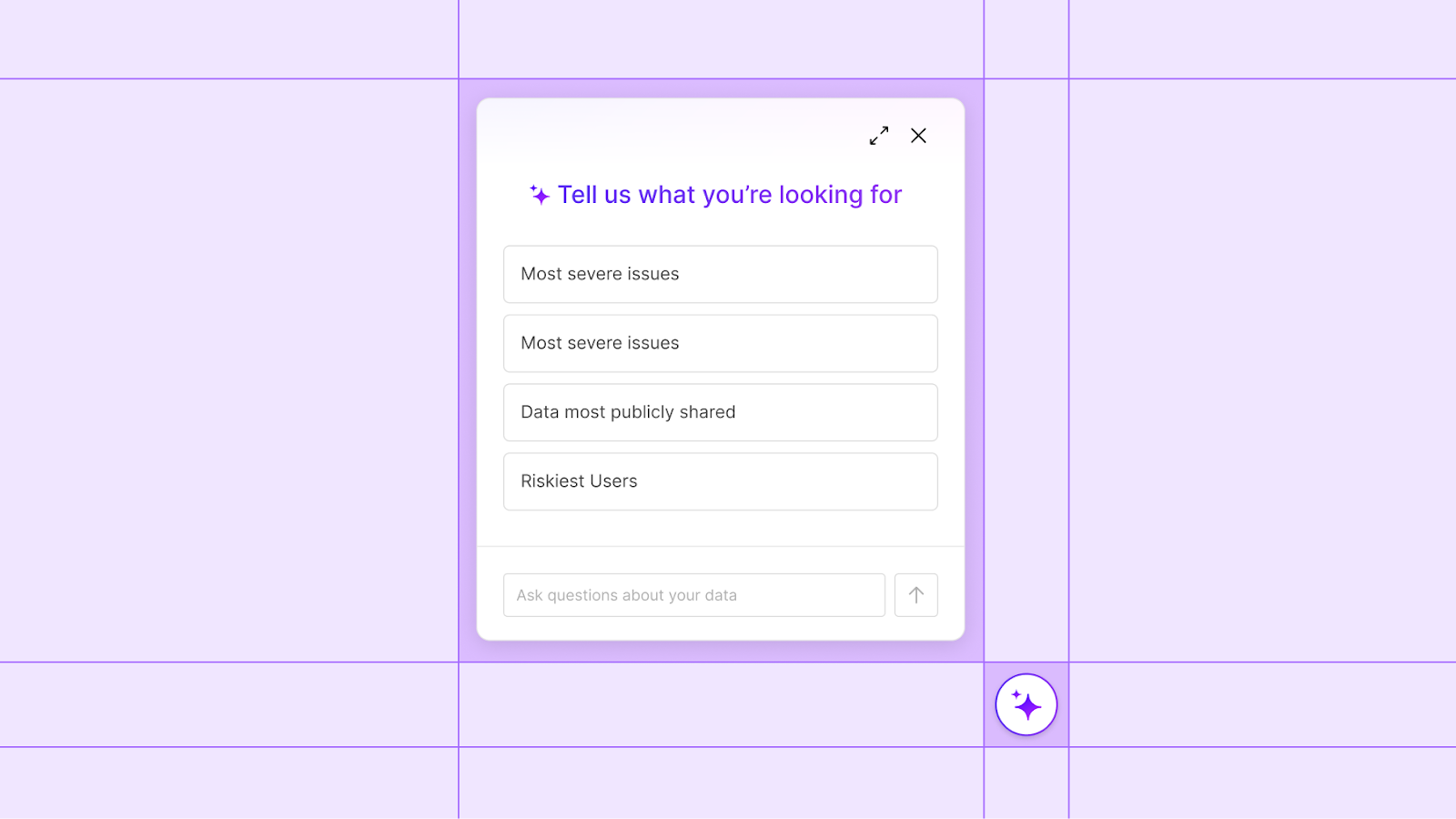
Chat conversationnel basé sur l'IA pour découvrir rapidement les risques liés aux données
Les équipes de sécurité sont confrontées à un flot constant d'alertes, dont beaucoup manquent de contexte clair ou de hiérarchisation des priorités. Une erreur de configuration passée inaperçue aujourd'hui peut devenir une véritable brèche demain. Et si vos analystes pouvaient tirer parti d'un assistant d'intelligence artificielle en langage naturel pour interroger les risques, localiser rapidement les expositions et concentrer leurs efforts sur les menaces les plus impactantes ?
Le défi du contexte et de la rapidité
La plupart des outils de sécurité génèrent des alertes sans expliquer l'importance d'une découverte ni la marche à suivre. Les équipes passent des heures à parcourir les journaux, les feuilles de calcul et les tableaux de bord cloisonnés uniquement pour répondre à des questions de base : quels ensembles de données sont exposés ? Qui peut y accéder ? Quel est le degré d'urgence du risque ? Au moment où un analyste identifie une exposition critique, les acteurs de la menace l'exploitent peut-être déjà.
Présentation d'Omni AI
Omni AI est l'interface de chatbot basée sur la plateforme de sécurité des données de Cyera qui permet aux équipes de sécurité de poser des questions en langage naturel sur les indicateurs de risque en temps réel et d'obtenir des réponses instantanées et prioritaires. Il combine l'indexation des données en temps réel avec les LLM pour fournir :
- Résumés instantanés des risques: Posez la question suivante : « Quelles données exposées présentent le plus grand risque à l'heure actuelle ? » et recevez une liste de classement avec les détails de l'exposition et les facteurs de risque. Les requêtes en langage naturel éliminent les obstacles à l'obtention d'informations. Les analystes évitent le triage manuel et passent directement aux résultats les plus critiques.
- Explorez le détail avec des suivis: Requête « Montrez-moi les cinq compartiments cloud les plus mal configurés en fonction de la sensibilité des données. Vous pouvez même poser des questions plus générales telles que : « Quelles sont mes meilleures opportunités pour réduire les risques avec le moins d'effort possible ? » Plus besoin d'écrire des requêtes de recherche personnalisées ou de créer des filtres complexes.
- Contexte exploitable: Chaque réponse inclut des liens vers les résultats des risques sous-jacents dans Cyera, afin que vous puissiez prendre des mesures correctives sans changer d'outil. Et comme Cyera indexe les risques liés aux données dans tous les environnements, vous disposez d'un point de contact unique dans Omni AI pour toutes vos informations.
Comment cela fonctionne dans la pratique
Supposons qu'un SOC détecte des modèles d'accès inhabituels dans un référentiel de fichiers. Plutôt que de corréler manuellement les journaux et les inventaires d'actifs, un analyste peut ouvrir Omni AI et saisir une question :
« Quelles banques de données contenant des données clients réglementées sont actuellement autorisées par le public ? »
En quelques secondes, Omni AI renvoie une liste des expositions, met en évidence le score de risque pour chaque banque de données et affiche la date de dernière modification des autorisations. Vous pouvez également demander à l'assistant des rapports détaillés sur des éléments critiques tels que la conservation des données.
Omni AI est en version bêta privée aujourd'hui. Vous souhaitez en savoir plus ? Contactez votre représentant Cyera.
Remédiation M365
Améliorations apportées à la remédiation de Microsoft 365
La visibilité ne suffit pas : Cyera propose désormais une solution intégrée pour remédier aux risques liés aux données de Microsoft 365
Dans le domaine de la cybersécurité, l'objectif est depuis longtemps la visibilité. Il est essentiel de savoir où se trouvent vos données sensibles, qui y a accès et comment elles sont utilisées. Mais la visibilité sans pouvoir d'action peut paralyser les équipes de sécurité, qui voient les risques s'accumuler sans aucun moyen évolutif de les résoudre.
Cyera change cela en offrant une exploitabilité en matière de sécurité des données avec remédiation native de partage public et à l'échelle de l'organisation dans Microsoft 365.
Les risques se cachent à la vue de tous dans Microsoft 365
Microsoft 365 rend le partage de fichiers rapide et facile. En quelques clics, les utilisateurs peuvent sélectionner « Toute personne disposant du lien » ou « Personnes de votre organisation » pour partager des fichiers à grande échelle entre les équipes, les services ou même en externe.
Mais cette facilité comporte des risques. Par exemple :
- Un responsable du recrutement télécharge les données salariales sur SharePoint et les partage avec « Les membres de votre organisation », exposant ainsi les fichiers RH sensibles à l'échelle de l'entreprise.
- Un responsable financier envoie une feuille de calcul aux auditeurs externes en utilisant « Toute personne disposant du lien », puis oublie de révoquer l'accès une fois le projet terminé.
- Un dossier marketing contenant les coordonnées des clients est stocké dans un dossier public Sharepoint.
Dans chaque cas, des données sensibles sont exposées sans intention claire, et les équipes de sécurité ne s'en rendent souvent même pas compte. Mais il ne suffit pas de voir le risque.
Révoquez l'accès public instantanément, pas seulement une alerte

Cyera permet aux équipes de sécurité de prendre des mesures correctives directes et intégrées à la plateforme sur les fichiers Microsoft 365 partagés publiquement via « Toute personne disposant du lien ». Au lieu de vous contenter d'émettre des alertes, Cyera vous permet de contrôler le nettoyage des expositions sensibles à grande échelle.
Les principales fonctionnalités incluent la capacité à :
- Identifiez les liens de partage publics dans SharePoint, OneDrive et Teams
- Détectez automatiquement les expositions à l'aide de la classification native de l'IA et de l'application des politiques
- Découvrez le propriétaire, la sensibilité, la portée du partage et s'il s'agit d'un accès direct ou indirect
- Révoquez l'accès public en un seul clic ou en masse
- Maintenir une piste d'audit complète de toutes les mesures correctives
Par exemple, un analyste financier partage une feuille de calcul de prévisions sensibles avec des partenaires externes mais oublie de désactiver l'accès. Dans ce scénario, Cyera apporte son aide en :
- Marquer le fichier comme étant à la fois partagé publiquement et contenant des données financières sensibles
- Faire apparaître automatiquement le contexte complet du fichier
- Activation de la révocation en un clic de l'accès public
- Enregistrement de l'action à des fins de reporting et de conformité
Restreignez l'accès à l'échelle de l'entreprise sans perturber l'activité
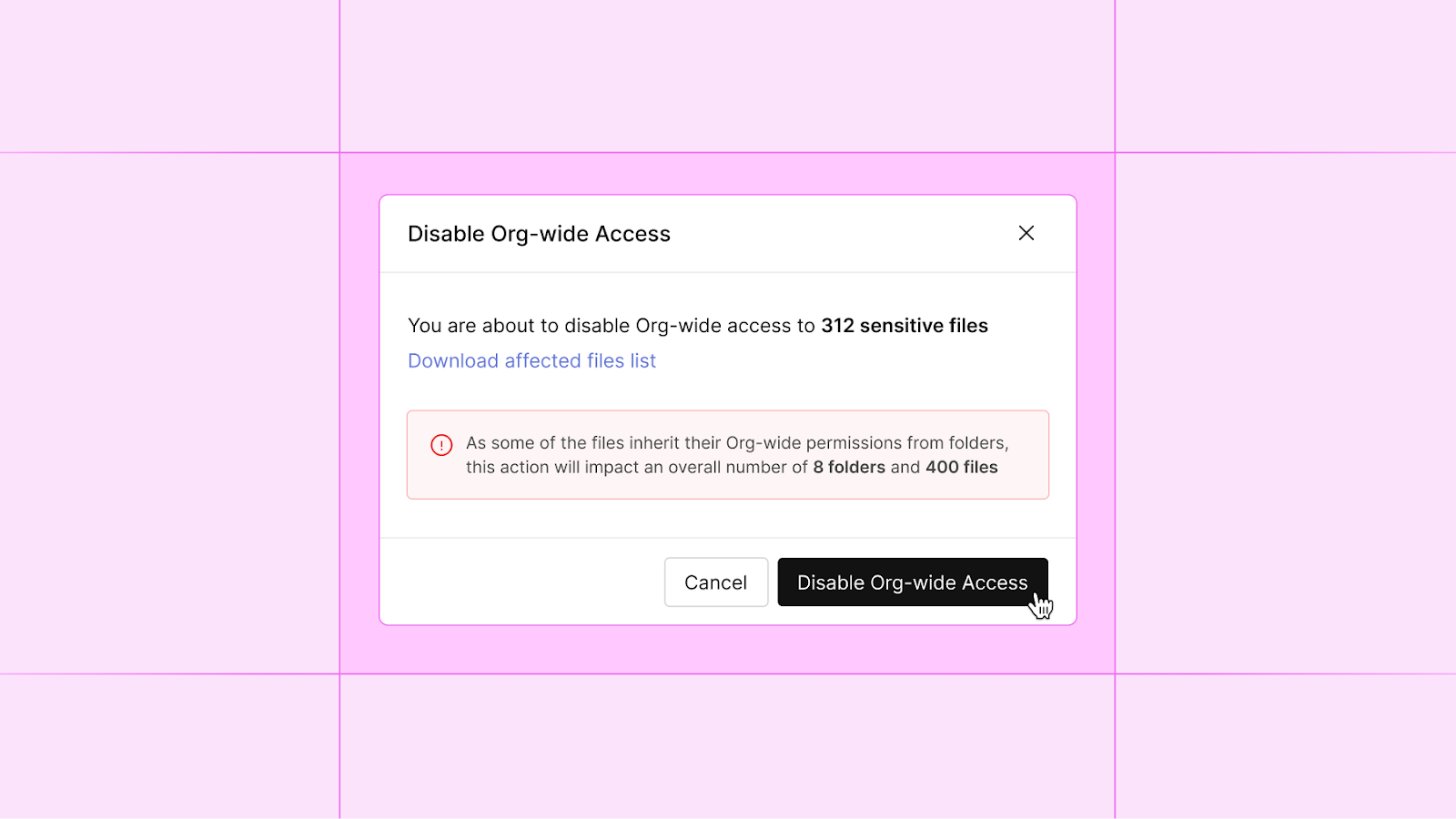
Cyera répond également aux risques liés au partage de fichiers ou de dossiers Microsoft 365 avec l'ensemble de l'organisation, exposant ainsi les données sensibles plus largement que prévu. Les équipes de sécurité peuvent réduire l'accès sans interrompre les flux de travail légitimes.
Les principales fonctionnalités incluent la capacité à :
- Détectez le partage à l'échelle de l'organisation entre SharePoint, OneDrive et Teams
- Classifier le contenu sensible et identifier les configurations de partage héritées
- Révéler la structure des fichiers ou des dossiers, les chemins d'accès et les niveaux de sensibilité
- Révoquez l'accès de manière sélective ou groupée tout en préservant l'accès pour les utilisateurs autorisés
- Suivez et signalez toutes les modifications grâce à des journaux d'audit complets
Par exemple, un dossier RH est partagé avec l'ensemble de l'entreprise, exposant les données salariales des employés. Ici, Cyera peut rapidement :
- Marquer le dossier en fonction des politiques par défaut pour les données sensibles
- Afficher l'accès hérité et identifier qui peut voir le contenu
- Permettre de limiter l'accès à l'équipe des ressources humaines
- Assurez-vous que toutes les actions sont enregistrées à des fins d'audit et de conformité
Pourquoi c'est important : le passage de la prise de conscience à la résolution
La plupart des outils de sécurité font bien une chose : les problèmes de surface. Mais en réalité, la visibilité au niveau de la surface sans remédiation intégrée ne suffit plus.
Voici pourquoi :
- Le volume de données est trop important pour être géré uniquement par le biais d'enquêtes manuelles et de la billetterie.
- Les attaquants exploitent les erreurs de configuration des accès rapidement et à grande échelle.
- Les auditeurs exigent la preuve non seulement d'une prise de conscience, mais aussi d'un contrôle actif.
En intégrant la solution à la même plateforme qui identifie le problème, Cyera aide les équipes à boucler la boucle plus rapidement et en toute confiance. Il suffit de revoir, d'agir et de passer à autre chose.
L'actionnabilité est le nouvel impératif de sécurité
La sécurité moderne des données ne se limite pas à la détection. C'est une question de résolution. Et la résolution ne se limite pas à l'exportation de rapports ou à l'ouverture de tickets. Elle nécessite la capacité d'intervenir directement et en toute sécurité, en temps réel.
La vision de Cyera est de rendre chaque risque lié aux données immédiatement exploitable, dans les environnements cloud, SaaS et sur site. Parce que lorsque vous sécurisez les données et corrigez l'exposition, c'est là que la sécurité fonctionne vraiment.
Essayez-le dès maintenant
La solution de correction de Microsoft 365 est disponible dès aujourd'hui pour tous les clients de Cyera utilisant SharePoint, OneDrive ou Teams.
Si vous êtes prêt à aller au-delà de la visibilité et à prendre des mesures concrètes pour faire face aux risques liés à vos données, entrer en contact pour voir Cyera en action. La visibilité vous aide à identifier le problème. Actionability vous aide à le résoudre.
Avec Cyera, vous bénéficiez des deux.
Contexte basé sur l'âge
Contexte des données et contrôles basés sur l'âge
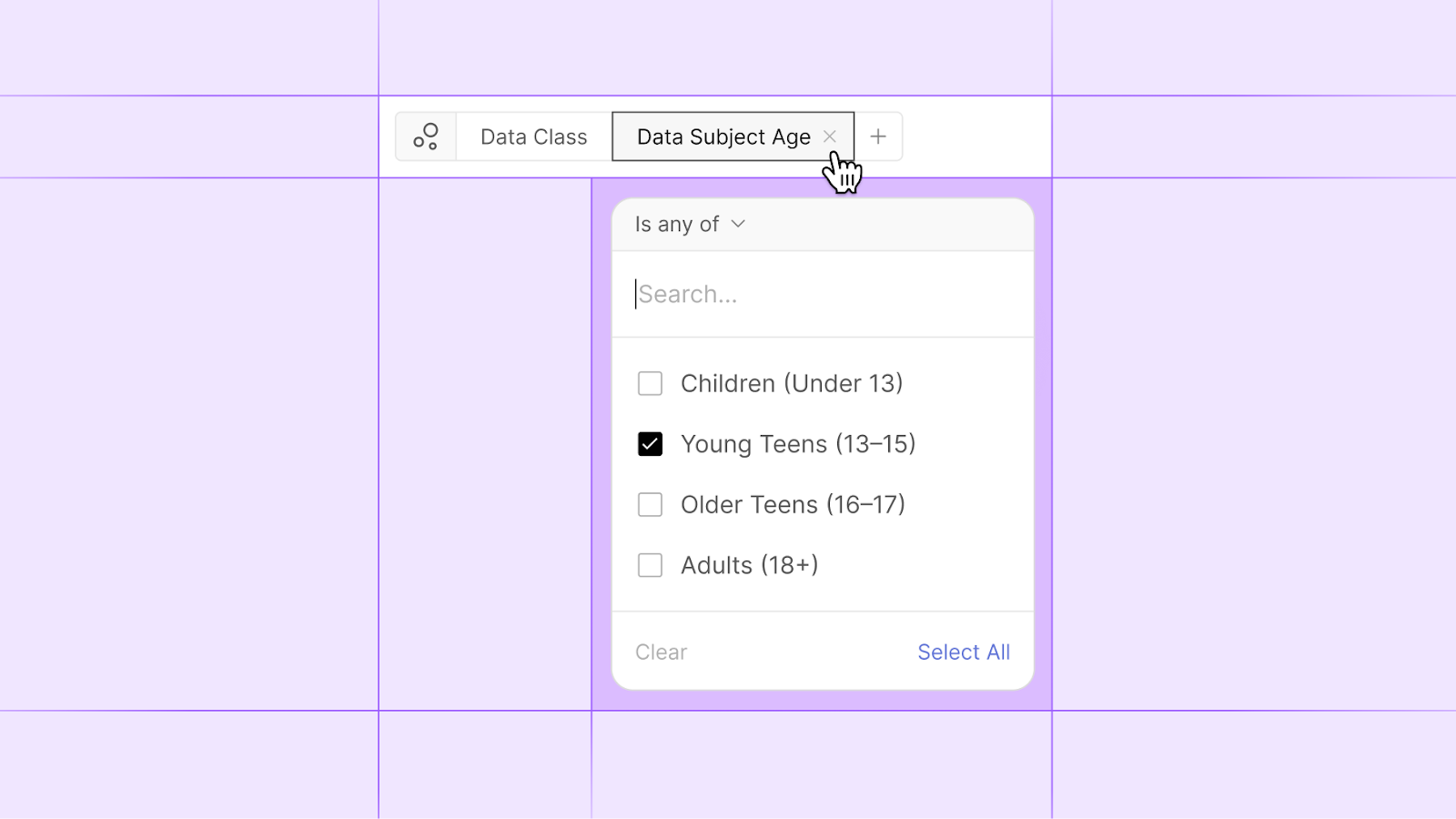
Identifiez et appliquez automatiquement les contrôles en fonction de l'âge des personnes concernées
Les lois sur la protection des données sont de plus en plus précises sur un point : le contexte est important. Surtout en ce qui concerne l'âge. Qu'il s'agisse d'obtenir le consentement des parents ou de minimiser les données pour les utilisateurs mineurs, il n'est plus facultatif de savoir si la personne concernée est un enfant, un adolescent ou un adulte. Cyera fournit désormais ce contexte aux équipes chargées de la sécurité et de la confidentialité. Automatiquement.
Ajouter l'âge à l'équation de la protection de la vie privée
Jusqu'à présent, la plupart des entreprises disposaient de données sur les dates de naissance de leurs clients, mais les transformer en mesures réglementaires nécessite un effort manuel ou une logique externe. Le nouveau contexte de données sur les groupes d'âge de Cyera comble cette lacune. Il classe les individus en quatre groupes distincts en fonction du contexte : enfants (moins de 13 ans), jeunes adolescents (13 à 15 ans), adolescents plus âgés (16 à 17 ans) ou adultes (18 ans et plus). Cela permet de prendre des décisions de classification et de gouvernance précises, conformes aux obligations légales.
Age Group rejoint les fonctionnalités Data Context existantes de Cyera, qui incluent déjà les rôles des personnes concernées (tels que les employés, les fournisseurs ou les clients) et la résidence des personnes concernées (qui identifie la juridiction qui s'applique à un enregistrement). Ensemble, ils fournissent une image plus complète du risque d'atteinte à la vie privée, qui s'aligne sur les cadres réglementaires modernes dans toutes les zones géographiques.
Du PI au SPI : augmentation de la sensibilité en fonction de l'âge
Supposons que votre équipe analyse les bases de données clients et découvre une colonne contenant les dates de naissance. Historiquement, Cyera qualifiait cette colonne d'informations personnelles (IP). Désormais, si le système détermine que certains de ces dossiers appartiennent à des personnes de moins de 13 ans, cette classification peut automatiquement être élevée au rang d'informations personnelles sensibles (SPI), qui ont des exigences de confidentialité distinctes.
Ce petit changement a de grandes implications :
- HIPAA, PHIPA, PIPEDA : Toutes mettent l'accent sur la protection spéciale des informations sur la santé des mineurs. L'identification de l'âge d'une personne concernée favorise un traitement et des contrôles d'accès appropriés.
- GLBA : exige la protection des données financières des consommateurs, avec une sensibilité accrue pour les mineurs dans certains contextes (par exemple, les données sur les prêts étudiants).
- LGPD : nécessite des mécanismes de consentement spécifiques pour le traitement des données des enfants de moins de 12 ans.
Un cas d'utilisation, de nombreux risques évités
Des politiques de sécurité et de consentement différentes s'appliquent aux clients en fonction de leur âge, et ces règles ne peuvent pas être appliquées si vous ne pouvez pas classer les enregistrements de manière fiable. Grâce au contexte du groupe d'âge, vous pouvez désormais détecter la présence de mineurs dans un ensemble de données, améliorer la classification des risques et lancer des contrôles tels que le cryptage, les restrictions d'accès ou même la suppression basée sur des règles.
Automatiser la précision réglementaire
Les réglementations sont nuancées, tout comme les données. La charge qui pèse sur les équipes chargées de la sécurité et de la confidentialité n'est pas seulement de protéger les informations, mais d'appliquer les bonnes protections en fonction de l'identité des personnes à qui les données appartiennent. Le contexte des données sur les groupes d'âge permet de :
- Mise à niveau automatique de la classification lorsqu'une date de naissance indique un mineur
- Déclencheurs de conformité liés aux politiques spécifiques à l'âge
- Des rapports plus précis pour les audits ou les analyses d'impact sur la protection des données (DPIA)
- Soutien à la réduction proactive des risques et à l'analyse de l'impact des violations
L'avenir passe par la sécurité des données contextuelle
À mesure que les réglementations en matière de confidentialité évolueront, la conformité dépendra moins des étiquettes statiques que du contexte dynamique. Cyera s'engage à construire cet avenir. Le contexte du groupe d'âge de la personne concernée constitue une autre étape pour aider les organisations à passer des contrôles généraux à des protections ciblées et significatives en fonction de la personne que les données décrivent réellement.
Vous voulez voir comment cela fonctionne ? Demandez une démo pour découvrir comment Cyera peut vous aider à automatiser les contrôles en fonction de l'âge et à réduire les risques réglementaires.
Nouvelles langues
Aide à la classification en portugais et en espagnol

D'abord en anglais et en français, maintenant classification et contexte pour le portugais et l'espagnol
La langue est importante pour la sécurité des données. Les identifiants tels que le CPF au Brésil ou le CURP au Mexique, lorsqu'ils sont stockés dans des documents ou des bases de données, sont essentiels pour la conformité aux lois locales en matière de confidentialité. Pourtant, de nombreux outils de sécurité ont du mal à classer avec précision les données dans des langues autres que l'anglais.
Cyera comble cet écart. Avec cette version, notre plateforme comprend et classe désormais les données sensibles écrites en portugais et en espagnol. Qu'il s'agisse d'une pièce jointe à un e-mail contenant une carte d'identité nationale espagnole ou d'un champ de base de données RH contenant des numéros de santé brésiliens, Cyera le voit, le comprend et le classe avec précision.
Classification apprise, granulaire et multiniveaux
Cyera ne se contente pas de traduire les données. Il en tire des leçons. Notre classification multilingue capture les nuances de la façon dont les informations sont écrites, structurées et réglementées dans les environnements espagnol et portugais, sans nécessiter de configuration manuelle.
Pour ce faire, Cyera applique un modèle de classification à plusieurs niveaux :
- Au niveau des éléments : détecte des champs tels que les noms, les informations d'identification ou les identifiants gouvernementaux dans les langues maternelles, en reconnaissant les modèles spécifiques aux formats espagnol et portugais.
- Au niveau de l'objet : évalue des fichiers ou des dossiers entiers en fonction de leur sensibilité globale et de leur contexte, des formulaires fiscaux aux dossiers médicaux.
- Métadonnées et classification contextuelle : identifie si les données concernent un employé, un client, un mineur ou tout autre type de personne concernée et applique les bons signaux de conformité.
Cyera apprend également automatiquement de nouvelles classifications, en s'adaptant à la façon dont votre organisation nomme et structure les données. Pas de regex. Pas de marquage. Il n'y a pas de règles Le résultat est une classification précise, adaptée à la région et prête à l'emploi. Moins de configuration. Plus de contexte. Et un support qui évolue en fonction de vos données.
Conçu pour une échelle mondiale
Cette mise à jour s'inscrit dans le cadre de notre mandat visant à soutenir les opérations mondiales. Nous avons développé l'extension du modèle sous-jacent pour garantir une classification multilingue cohérente dans l'ensemble de votre parc de données. Cela signifie que vous pouvez :
- Exécutez des politiques uniformes pour les opérations multinationales, peu importe où se trouvent les données ou comment elles sont écrites
- Soutenir les programmes GRC en les alignant davantage sur les régions, en veillant à ce que les données sensibles soient découvertes et régies selon les bonnes règles juridictionnelles
- Évoluez sur le plan opérationnel en supprimant la nécessité d'ajuster les regex spécifiques à une région ou de réécrire les politiques
Pour les entreprises internationales, cela se traduit par une intégration plus rapide sur de nouveaux marchés, une réduction du risque de non-conformité et une réduction des frais de sécurité.
Des avantages concrets
Supposons que votre organisation ait son siège social aux États-Unis, mais qu'elle ait récemment acquis une société de médias au Mexique. Cette société stocke le contenu généré par les utilisateurs, les e-mails des clients et les dossiers de facturation en espagnol via un ancien partage de fichiers et une base de données cloud. Quelques heures après le déploiement de Cyera, vous pouvez :
- Classer automatiquement les données en espagnol
- Signaler les données stockées dans la mauvaise région ou exposées à un accès trop permissif
- Appliquez des politiques locales de protection des données appropriées, sans créer d'ensembles de règles personnalisés
Multipliez maintenant cela entre plusieurs équipes, langues et unités commerciales. C'est ainsi que la classification multilingue accélère la sécurité, la conformité et la gouvernance à grande échelle.
Une plateforme unique, une couverture mondiale
L'espagnol et le portugais rejoignent la liste croissante des langues prises en charge par Cyera, y compris des ajouts récents comme le français. Et ce n'est que le début. Nous nous engageons à aider les entreprises internationales à découvrir et à protéger les données sensibles dans la langue dans laquelle elles ont été créées.
Ainsi, si vous souhaitez vous développer en Amérique latine, gérer la conformité transfrontalière ou travailler à l'unification de la protection des données dans le monde entier, Cyera vous permet désormais de le faire plus facilement et en toute confiance.
Êtes-vous prêt à voir la classification multilingue en action ? Demandez une démo et découvrez comment Cyera vous aide à sécuriser les données où qu'elles se trouvent, dans n'importe quelle langue.
Place de marché des intégrations
Toute nouvelle place de marché des intégrations

Connectez, automatisez et renforcez facilement l'ensemble de votre écosystème de sécurité
Pour faciliter l'intégration, Cyera introduit la gestion centralisée de l'intégration, votre hub unique pour une connectivité de sécurité fluide. Au lieu de passer d'une plateforme à l'autre, vous disposez désormais d'un endroit unique pour intégrer les intégrations, gérer les accès et résoudre les problèmes.
Cette puissante fonctionnalité permet aux entreprises de connecter facilement Cyera à leur stack de sécurité existant tout en conservant un contrôle total sur leurs intégrations.
Pourquoi c'est important
La gestion des intégrations ne devrait pas être un fardeau ; elle devrait servir de catalyseur pour renforcer la sécurité.
Grâce à la gestion centralisée de l'intégration, vous pouvez :
- Habiliter les équipes : donnez aux propriétaires de données la capacité de gérer les problèmes de sécurité directement via leurs outils de billetterie et de communication préférés.
- Renforcez l'intelligence de sécurité : intégrez les classifications précises et exploitables de Cyera à votre SIEM, à votre catalogue de données et à d'autres systèmes critiques.
- Améliorez votre posture de sécurité : utilisez des intégrations bidirectionnelles pour renforcer l'ensemble de votre écosystème de sécurité.
- Simplifier la gestion : utilisez la gestion centralisée des intégrations pour intégrer et surveiller les intégrations en toute simplicité.
Aujourd'hui, la sécurité ne consiste pas seulement à disposer des bons outils, mais à les faire fonctionner ensemble de manière fluide. Les puissantes intégrations de Cyera améliorent votre écosystème de sécurité, garantissant une protection des données proactive, intelligente et efficace.
La puissance des intégrations de Cyera
Une solution de sécurité bien intégrée n'est pas seulement pratique, elle est également transformatrice. Les intégrations de Cyera offrent trois avantages fondamentaux qui améliorent les opérations de sécurité :
- Démocratiser la remédiation: En s'intégrant aux systèmes de billetterie, aux notifications par e-mail et aux applications de messagerie instantanée, Cyera permet aux propriétaires de données de résoudre les problèmes de sécurité de manière indépendante. Cela permet de réduire les goulots d'étranglement, d'accélérer les délais de résolution et de répartir les responsabilités au sein de l'organisation.
« Le moment où un risque est détecté est le moment d'agir. Notre partenariat avec Cyera transforme ce moment en action en déclenchant automatiquement les flux de travail de Tines à partir de signaux de risque en temps réel afin que les équipes puissent résoudre les problèmes plus rapidement, réduire leur fenêtre d'exposition et renforcer leur posture de sécurité. »
Charlie Ardagh, responsable des partenariats, Tines
La plateforme d'orchestration des flux de travail et de l'IA de Tines permet aux entreprises de fonctionner plus efficacement, d'atténuer les risques, de réduire la dette technologique et de faire le travail qui compte le plus.
- Améliorer le renseignement de sécurité: Le moteur de classification des données de pointe de Cyera enrichit votre catalogue de données, votre SIEM et d'autres systèmes de sécurité avec les classifications les plus précises et les plus pertinentes disponibles. Cela garantit que les équipes de sécurité disposent des meilleurs renseignements possibles sur lesquels agir.
- Intégration bidirectionnelle pour un écosystème plus solide: Cyera ne se contente pas d'intégrer, il améliore. En se synchronisant avec la gestion des identités, les logiciels de sauvegarde et d'autres outils de sécurité, nos intégrations bidirectionnelles améliorent l'automatisation, la visibilité et le contrôle de votre environnement, garantissant ainsi une stratégie de sécurité plus cohérente.
« Cette intégration de premier ordre entre Cohesity et Cyera permet aux entreprises de renforcer leur position en matière de sécurité des données en combinant la découverte intelligente des données avec une gestion des données robuste et sécurisée. Ensemble, nous réduisons l'écart entre la visibilité et le contrôle des données sensibles afin que les clients puissent réduire les risques de manière proactive, simplifier la conformité et reprendre leurs activités en toute confiance. Il s'agit d'une avancée importante pour aider les organisations à élaborer une stratégie de cyberrésilience complète et efficace. »
Sheetal Venkatesh, vice-président de la gestion des produits, Cohesity.
Reconnue par plus de 13 600 entreprises, dont 85 du Fortune 100, Cohesity aide les organisations à renforcer leur résilience et à protéger les données dans les environnements sur site, cloud et périphériques tout en débloquant des informations grâce à l'IA générative.
Création d'un écosystème de sécurité adapté à vos besoins
Votre système de sécurité devrait fonctionner pour vous, et non l'inverse. En supprimant les frictions liées au processus d'intégration, nous permettons aux équipes de développer et de maintenir plus facilement une posture de sécurité solide et adaptable.
Ce n'est que le début. Chez Cyera, nous nous engageons à aider les équipes de sécurité à agir plus rapidement, à garder une longueur d'avance sur les menaces et à travailler en toute confiance. Parce que lorsque les opérations de sécurité se déroulent correctement, les entreprises peuvent prospérer.
Prêt à prendre le contrôle de vos intégrations ?
Si vous êtes prêt à découvrir comment Cyera peut rationaliser vos opérations de sécurité, obtenez une démo en direct dès aujourd'hui.
Résumé des innovations
Les points forts de l'innovation en un coup d'œil
AI Guardian : utilisation sécurisée de l'IA, de bout en bout
AI Guardian de Cyera est la première solution complète du secteur pour la sécurité de l'IA, combinant la gestion de la posture de sécurité de l'IA (AI-SPM) et la protection de l'exécution de l'IA.
- AI-SPM inventorie tous les systèmes d'IA (copilotes, LLM, outils internes) et cartographie leur exposition aux données, leur lignée et les risques.
- AI Runtime Protection applique des politiques en temps réel pour empêcher les injections rapides, les fuites de données et les abus avant qu'ils ne se produisent.
Omni AI : accès conversationnel aux risques liés aux données
Omni AI est la nouvelle interface conversationnelle de Cyera qui permet aux analystes de poser des questions en langage naturel telles que :
- « Quelles sont les données exposées qui présentent le plus de risques à l'heure actuelle ? »
- « À quels risques de conservation des données suis-je confronté aujourd'hui ? »
Basée sur l'indexation des risques en temps réel et les LLM, Omni AI propose instantanément des réponses prioritaires avec des liens vers les flux de travail de remédiation. Aucune requête complexe n'est requise.
Solution intégrée pour les risques liés à Microsoft 365
Cyera prend en charge la correction native du partage de fichiers public et à l'échelle de l'organisation dans Microsoft 365. Grâce à cette fonctionnalité, les équipes de sécurité peuvent :
- Découvrez qui a partagé quoi sur SharePoint, OneDrive et Teams
- Signaler automatiquement les fichiers surexposés à l'aide de la classification native de l'IA
- Révoquez l'accès public ou interne à grande échelle, directement sur la plateforme
- Maintenir une piste d'audit complète pour la conformité et la production de rapports
Contexte des données basé sur l'âge pour la précision de la classification
Cyera prend en charge le contexte des données par groupe d'âge, en classant automatiquement les personnes concernées en tant qu'enfants, adolescents ou adultes et en postulant :
- Classifications de sensibilité élevées (par exemple de PI à SPI)
- Déclencheurs de conformité ciblés
- Audit et analyse d'impact plus précis
Classification multilingue : désormais disponible en espagnol et en portugais
Cyera prend en charge la classification des données en espagnol et en portugais, en plus de l'anglais et du français. Grâce à des modèles multi-niveaux et sensibles au contexte, Cyera identifie :
- Éléments sensibles structurés et non structurés (par exemple CPF, CURP)
- Attributs réglementaires liés à la résidence et au rôle
- Contexte de la personne concernée pour des décisions de gouvernance précises
Tout nouveau marché d'intégration
Le nouveau marché d'intégration de Cyera permet de le connecter facilement à votre stack de sécurité existant. La nouvelle interface élimine les difficultés liées au processus de configuration de l'intégration, ce qui permet de :
- Gestion centralisée de l'intégration et de l'intégration
- Des flux de données bidirectionnels pour enrichir votre écosystème de sécurité
L'avenir de la sécurité des données est intelligent et exploitable
Ces mises à jour reflètent notre engagement à aider les équipes de sécurité à faire plus que détecter les risques. Ils peuvent agir en temps réel, dans les environnements cloud, SaaS et sur site.
Vous voulez voir ces fonctionnalités en action ? Demandez une démo pour découvrir comment Cyera vous aide à protéger vos données, à sécuriser votre utilisation de l'IA et à rationaliser vos opérations de sécurité en toute confiance.
Obtenez une visibilité complète
avec notre évaluation des risques liés aux données.
